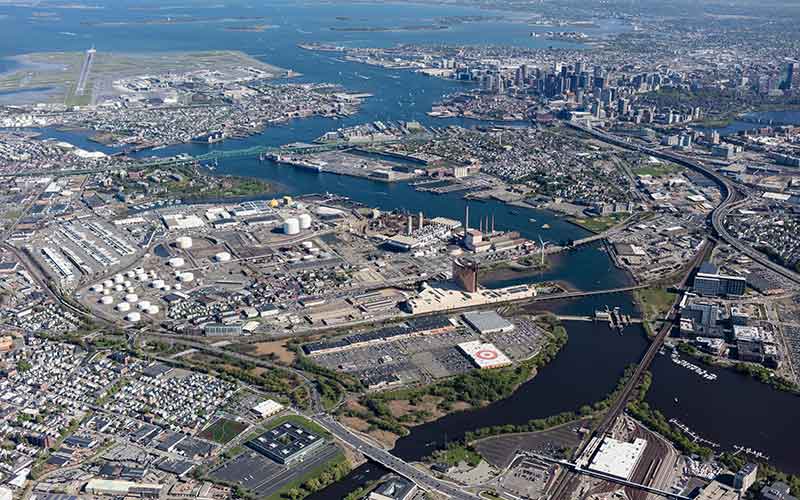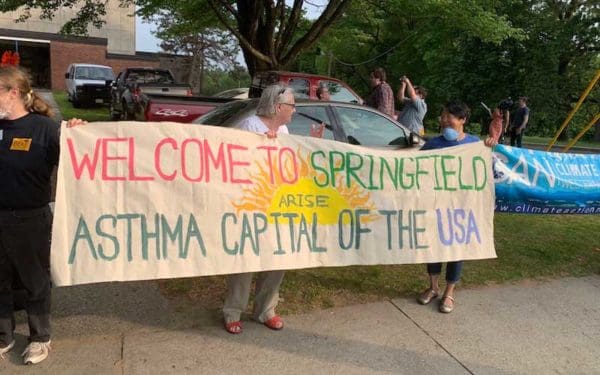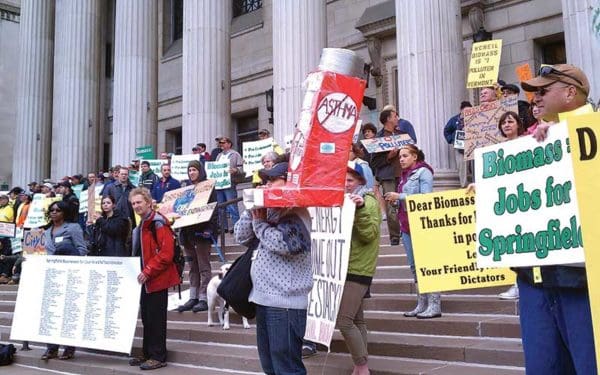
Environmental justice communities are often heavily industrialized, lacking green space and open land. Photo: Alex_Maclean
UPDATE: By unanimous vote, environmental justice language – which gives residents of historically disadvantaged neighborhoods more say in what happens in their own backyards – from one of our key bills has moved forward. This language has now been incorporated into the House Roadmap bill, which is being combined with the Senate Climate bill – a big win for both environmental justice and climate action. These critical climate bills are designed to help Massachusetts lower its polluting emissions by adding timelines and milestones to our existing Global Warming Solutions Act. With this new language, the climate bills will ensure that neighborhoods disproportionately impacted by pollution and other environmental harms are not left behind as we transition to a clean energy economy.
We must now pass these climate bills and codify this justice language into law. Contact your local legislators and urge them to support the Massachusetts Roadmap bill with this environmental justice language included.
Environmental justice requires reversing and repairing the impacts of decades of environmental racism. As we’ve discussed previously, low-income, immigrant, and communities of color have long been left out of conversations that affect the health of their neighborhoods. Residents of environmental justice communities are the most likely to bear the burdens of polluting industries and infrastructure, while having to fight for their share of resources we all need — healthy homes, schools, transit, food, and open space. Each of these disparities impacts the health of residents, while rendering whole communities less resilient to disasters like climate change or the COVID-19 crisis.
As part of my conversation about environmental justice with María Belén Power from GreenRoots, Andrea Nyamekye of Neighbor to Neighbor, and my CLF colleague Staci Rubin, we spoke about how racism directly contributes to these inequities.
Below is an excerpt from our conversation, edited for clarity.
How has racism contributed to environmental justice inequities?
María Belén Power, GreenRoots: Low-income communities and Black and Brown communities have been the sacrifice zones [so that] the rest of the region – and the country – have the benefits that industries bring.
I wasn’t working in Chelsea during this time, but the power plant fight [with Energy Management Inc. in 2007] is a good example. There was big disparity. The very same proponent that was proposing clean air for Nantucket through the Cape Wind project was proposing a dirty diesel power plant in Chelsea. That is a clear choice of where we are siting dirty industry and where we are siting clean energy infrastructure. So, who gets the benefit and who gets the burden?
That’s what we’re undoing [with environmental justice protections and the environmental justice movement]. We’re undoing the intentional siting of hazardous and polluting industries in communities that have already been, that already are, suffering from vulnerabilities of public health and access to transit and so many different burdens that are piling and piling and piling on.
What does environmental racism look like in our communities?
Andrea Nyamekye, Neighbor to Neighbor: I’ll use the chapters in which Neighbor to Neighbor organizes our “gateway cities of Massachusetts,” [as an example]. They’re all susceptible to the heat island effect [which is a huge public health problem]. Our Springfield chapter has the worst asthma rate in the nation. And I believe Holyoke has the second worst asthma in the State of Massachusetts, along with [high] child mortality and cancer [rates]. These things are not just by chance. They didn’t just pop up – but have been intentional. There’s been a lack of seeing these burdens in our communities.
I [also] want to bring up two campaigns that our Springfield folks and Holyoke folks did in the past years. And the first one is around the Gerena School tunnel. Gerena is a school in Springfield in a predominantly low-income and people of color neighborhood. Students have to walk through a tunnel under the highway to get to school, and the tunnel is filled with mold. It took us years just to [find] the right person who, in the State of Massachusetts, needs to clean up the mold in this tunnel.
The second is the Mt. Tom coal plant fight back in 2014. This coal plant had thousands of citations over decades, and it took a lot of community organizing saying, “you’re polluting our air and our water; this coal plant needs to shut down.” It took the uncovering of decades of citations to see that, like Springfield, Holyoke was getting the burden of all those impacts from the Mt. Tom coal plant.
María Belén Power, GreenRoots: Just to bring in the historical aspect: Andrea’s story reminded me of Chelsea’s history and how it went into receivership. Chelsea was the first city in the whole nation to go into receivership after the Great Depression. [The State] took over the schools, and they realized that they needed better schools – and a lot of the open space and green space was taken to build those schools. So, communities like Chelsea have had to face these really tough decisions of: do you get open space, or do you get schools? Which one do you want? It shouldn’t have to come down to that, because people really need good schools. But also, the life-long impact of having accessible open space and green space is really important.
[Environmental justice] affects so many different areas of our lives. It’s not just about clean air. And it’s not just about clean water. It’s so much more intertwined with our basic needs. To have language justice, education, [and] transit. It has deep, deep consequences if we truly have those protections for communities of color, low-income communities, and communities where English is not the first language.
How has environmental racism impacted transportation?
Staci Rubin, CLF: You can look at which communities have really long commute times or [where people] are waiting for buses in environments that are not pleasant to be in – you know, loud spaces without a bench to sit on. Those are primarily communities of color and low-income communities. There, the transit systems were not designed to help service workers or low-wage workers get to work outside of a nine-to-five timeframe.
For so many generations, there were commuter rails that passed through low-income communities of color and didn’t actually stop to pick up or discharge passengers. The idea was to get people from white, wealthier suburbs far away from Boston into the city as quickly as possible, while the pollution from those trains was burdening the folks who live closer in and weren’t able to benefit from getting on the train.
So environmental justice protections in that context look like affordable fares, reliable transit, the opportunities to see zero-emission vehicles or electric vehicles so that there are no tailpipe emissions contributing to the burden. It’s people actually benefiting by getting access to a service that they can use and depend on to get where they need to go.
What we need to do next
A set of environmental justice bills at the Massachusetts legislature will help combat these longstanding issues. The bills were designed to help reverse the impacts of these racist policies and protect communities from even more pollution. The protections in these bills start by including residents in conversations so they can shape the future of their own communities.
This blog is one in a series about environmental justice in Massachusetts, and the critical work being done in the legislature to address it. It was originally published on June 30, 2020. Read the entire series here.
María Belén Power is the Associate Executive Director of GreenRoots, a community-based and resident-led environmental justice organization working in Chelsea and East Boston, Massachusetts.
Andrea Nyamekye is the Campaign and Policy Director at Neighbor to Neighbor, a Massachusetts-based grassroots power-building organization working to improve quality of life for local communities.
Staci Rubin is a Senior Attorney at CLF focusing on transportation advocacy and its intersection with public health and the climate crisis.



